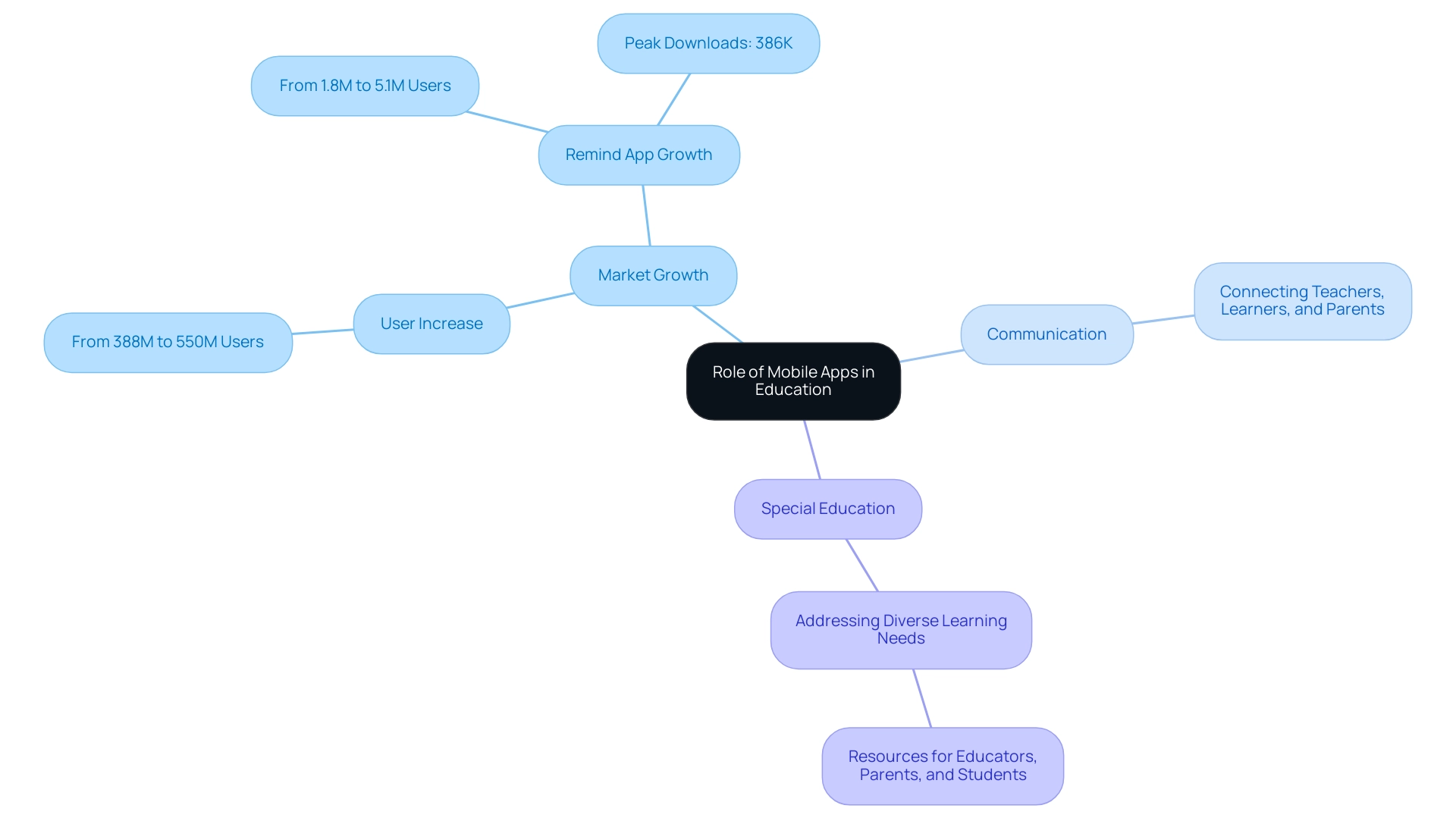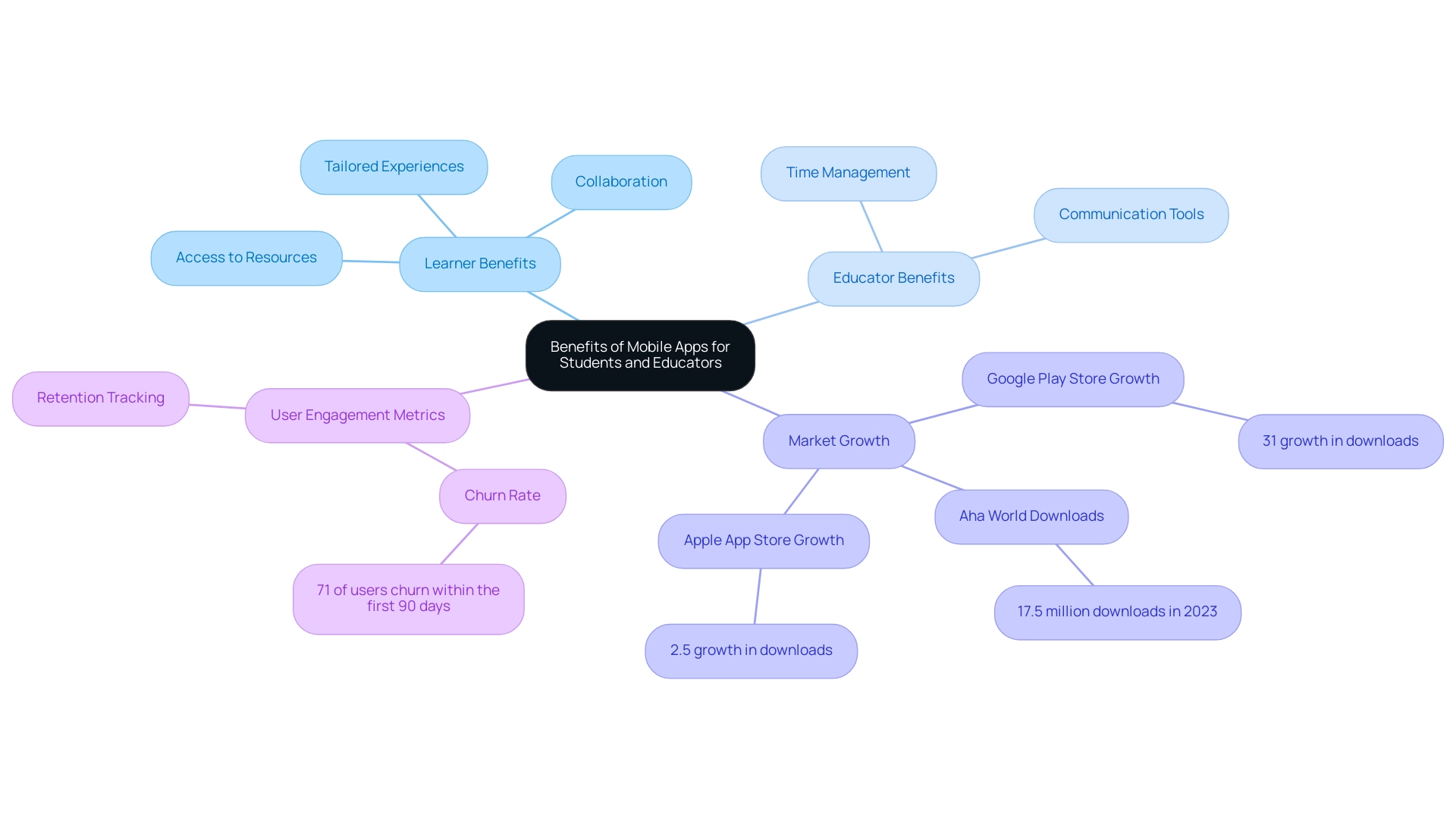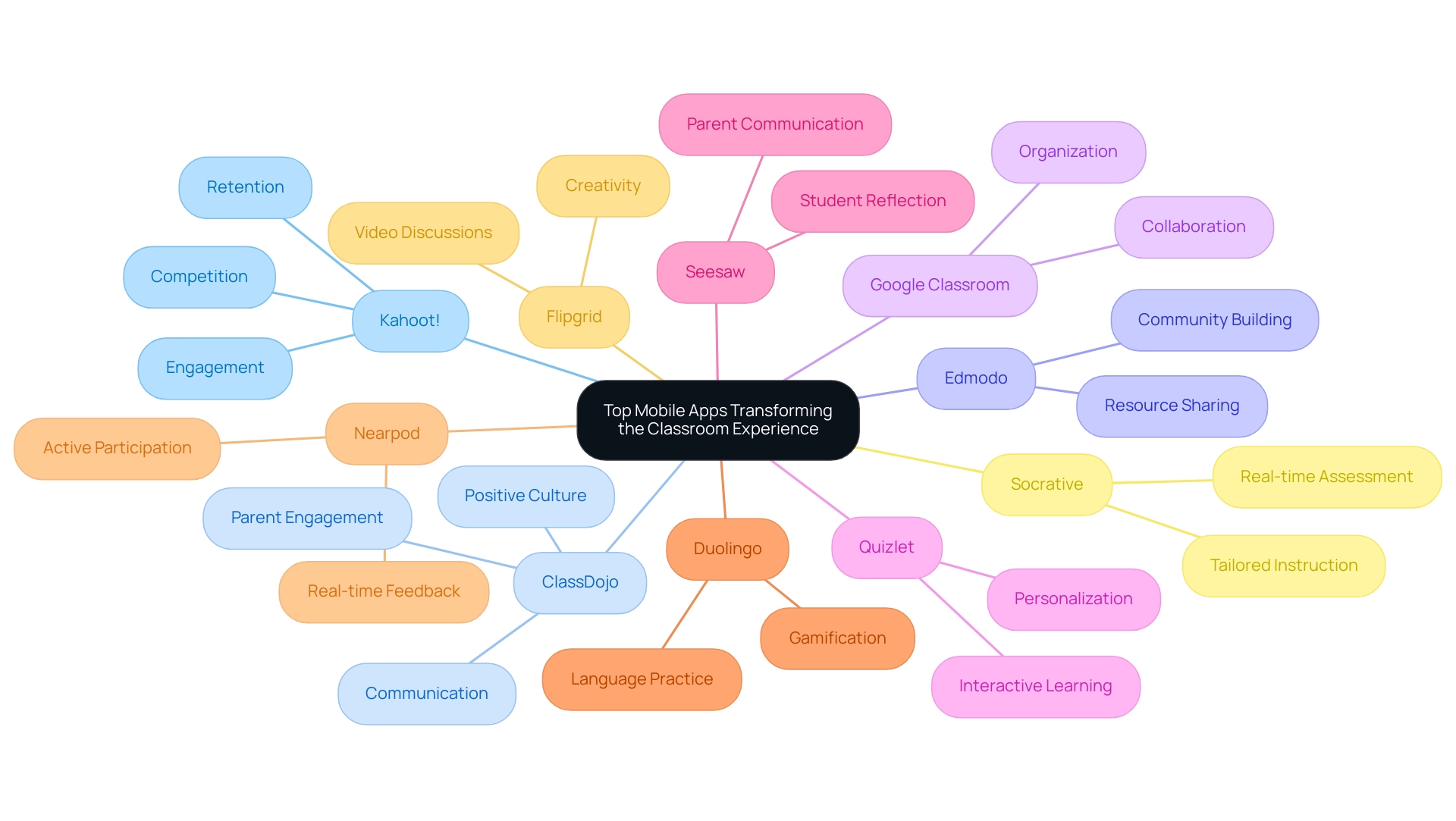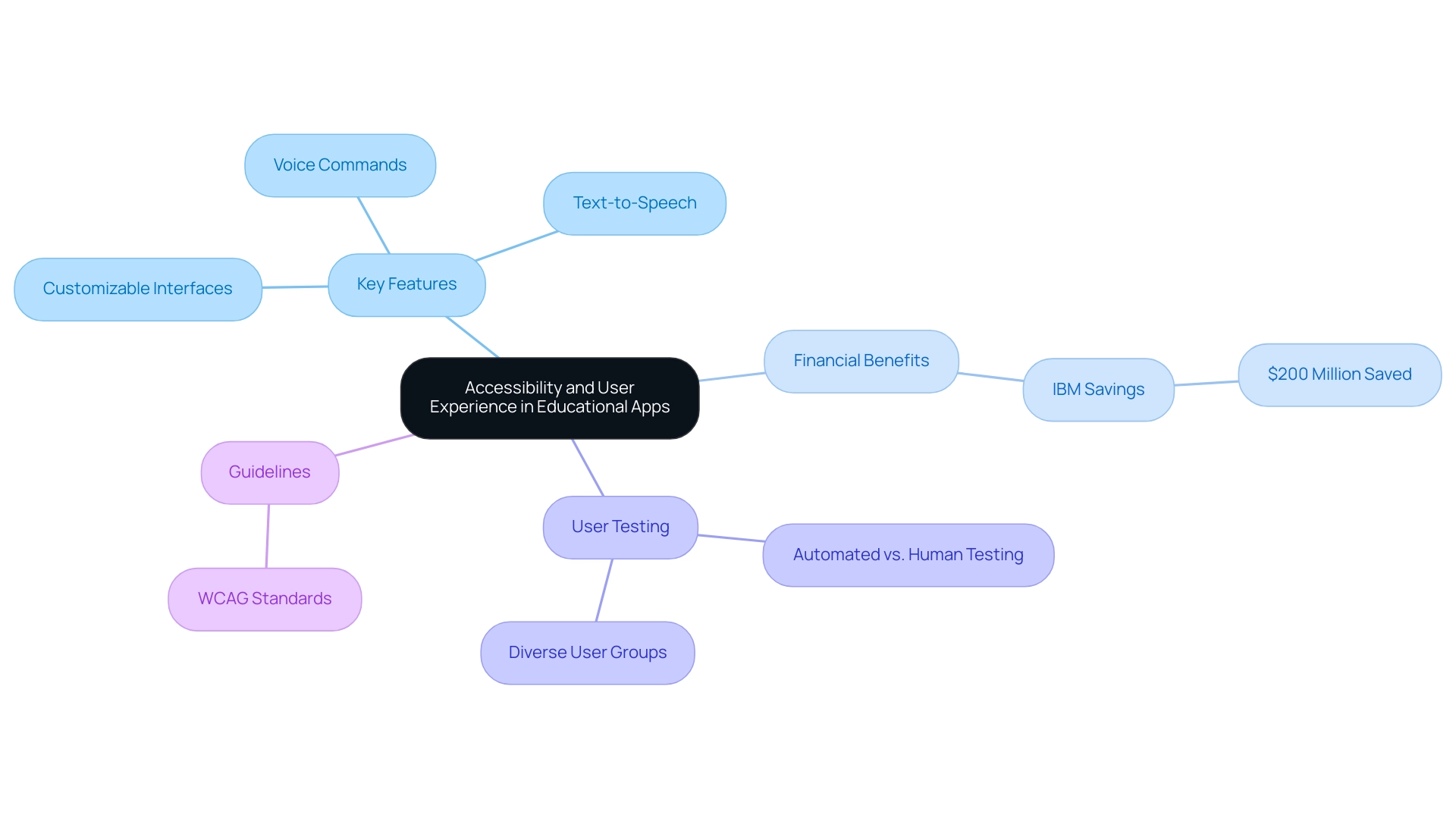Introduction
The rapid integration of mobile applications into the educational landscape is transforming how students learn and educators teach. With the surge in digital learning solutions, particularly during the pandemic, the education app market has witnessed unprecedented growth, boasting millions of users eager to embrace technology that enhances their learning experiences.
These applications not only provide personalized educational resources but also facilitate vital communication among teachers, students, and parents, creating a collaborative environment conducive to learning. As educational institutions increasingly adopt these tools, understanding their multifaceted roles becomes essential for maximizing their impact on educational outcomes.
From game-based learning platforms to communication tools that strengthen classroom dynamics, mobile apps are redefining the traditional classroom experience and paving the way for innovative approaches to education.
The Role of Mobile Apps in Modern Education
In recent years, mobile apps for schools have become crucial instruments in the educational landscape, significantly enhancing interactive and personalized experiences. As highlighted by a report from Business of Apps, which states, 'We believe this is the most comprehensive report available on the Education app market,' the education app market is thriving, with user numbers soaring from 388 million to 550 million during the pandemic, underscoring the shift towards digital learning solutions. These applications empower educators to present content in engaging formats, allowing learners the flexibility to learn at their own pace.
Furthermore, mobile applications function as essential communication pathways that connect teachers, learners, and parents, promoting a cooperative learning atmosphere. This evolving dynamic is particularly evident with platforms like Remind: School Communication, which saw its active user base grow from 1.8 million in early July to over 5.1 million by mid-September, with downloads peaking at 386,000 in early August. Additionally, mobile applications are valuable resources in special education, benefiting educators, parents, and learners in addressing diverse learning needs.
As academic institutions increasingly integrate technology into their curricula, comprehending the multifaceted role of mobile apps is essential for maximizing their potential to enhance learning outcomes.

Benefits of Mobile Apps for Students and Educators
Mobile apps for schools are transforming the learning environment, providing significant advantages for both learners and instructors. For learners, these applications provide access to a wealth of resources, encouraging tailored educational experiences that address personal requirements. A recent statistic highlights a significant trend: Aha World, for example, achieved an impressive 17.5 million downloads in 2023, illustrating the growing demand for learning apps.
Additionally, the Google Play Store experienced a remarkable 31% growth in downloads, while the Apple App Store saw a 2.5% increase, further emphasizing the expanding market for mobile applications in education. Educators, on the other hand, enjoy the advantages of streamlined communication tools that facilitate the efficient management of assignments, attendance, and feedback. As mentioned in Campus Technology, these tailored messages "assisted them in enhancing their time management, accessing resources such as financial aid renewal, and feeling more connected to their college."
Additionally, mobile apps foster collaborative environments where students can effortlessly participate in group projects and discussions, enhancing their overall academic experience. It is also worth mentioning BuildFire, a platform that enables educators to create iOS and Android apps simultaneously without coding, making app development more accessible. However, it is crucial to recognize that app usage is not guaranteed post-download; statistics show that 71% of users churn within the first 90 days.
Thus, tracking retention and churn metrics becomes essential for improving user engagement and app performance. By harnessing the myriad advantages of mobile applications, educational institutions can cultivate dynamic and effective educational environments that meet the evolving needs of today's learners.

Top Mobile Apps Transforming the Classroom Experience
-
Kahoot! This game-based educational platform transforms the classroom into an engaging environment where educators can create quizzes and interactive games. By incorporating elements of competition, Kahoot! enhances learner participation and retention, making education enjoyable and effective. Teachers using Kahoot! report increased engagement and motivation during lessons, resulting in better academic performance. This aligns with the trend of 63% of learners choosing to study online for its flexibility, which is increasingly supported by mobile apps for schools, as highlighted by Devlin Peck.
-
ClassDojo - As a powerful communication tool, ClassDojo connects teachers, learners, and parents, fostering a positive classroom culture. This app not only facilitates communication but also allows educators to share class updates, celebrate achievements, and manage behavior in a constructive manner. Real-world examples demonstrate that ClassDojo has significantly enhanced classroom dynamics by engaging parents in their children's learning journey, which is crucial as 25% of low-income youth face limited access to technology.
-
Edmodo - Functioning as a social educational network, Edmodo offers a secure and cooperative platform where learners and educators can share resources, engage in discussions, and work together on projects. This connectivity improves the experience by fostering a community of knowledge-sharing among peers, reflecting the growing trend of mobile apps for schools, as evidenced by the global downloads of educational apps like ChatGPT and Gemini in 2024.
-
Google Classroom - This free service enhances the sharing of files and resources between educators and learners. By enhancing collaboration, Google Classroom simplifies the educational process, allowing for seamless communication and organization, which is crucial in today’s digital educational environments. The flexibility offered by mobile apps for schools is a key factor driving the popularity of online education, as noted in the case study titled "Flexibility in Online Learning."
-
Quizlet - Quizlet enables learners to create study sets and flashcards, making education more interactive and personalized. With features like games and quizzes, this app assists users in retaining information efficiently, catering to various educational styles.
-
Seesaw - A student-driven digital portfolio, Seesaw enables learners to document and showcase their educational journey. This app fosters communication with parents and encourages learners to reflect on their work, enhancing their engagement and ownership of their educational experience.
-
Duolingo - Gamifying language acquisition, Duolingo makes obtaining new languages accessible and enjoyable. Its interactive approach encourages learners to practice regularly, significantly enhancing their language skills through a fun and engaging platform.
-
Nearpod - This interactive presentation tool allows teachers to create dynamic lessons infused with real-time feedback. Nearpod promotes active participation, allowing educators to evaluate understanding and adjust lessons accordingly, which is crucial in a responsive learning environment.
-
Flipgrid - By encouraging video discussions, Flipgrid fosters a sense of community among learners. This platform allows learners to express their thoughts and ideas through video responses, promoting creativity and collaboration while giving each individual a voice in the classroom.
-
Socrative - An assessment tool designed for real-time feedback, Socrative helps teachers gauge learner understanding through quizzes and polls. This immediate insight allows for timely interventions and tailored instruction, ensuring that all students receive the support they need to succeed.

Ensuring Accessibility and User Experience in Educational Apps
For learning applications to reach their full potential, developers must place a strong emphasis on accessibility and user experience. This involves creating applications that are not only intuitive and easy to navigate but also accommodating for users with disabilities. Incorporating features like voice commands, text-to-speech capabilities, and customizable interfaces can greatly enhance usability for all users.
Notably, the financial benefits of investing in accessible learning apps are illustrated by IBM's success, saving $200 million by shifting to online employee training, underscoring the potential return on investment. As emphasized in recent discussions, the significance of accessibility in learning technology is anticipated to increase in 2024, requiring proactive measures from developers. Furthermore, it is essential to conduct user testing with a diverse range of groups, supplementing automated testing with human evaluation to uncover less detectable accessibility issues.
Such thorough testing provides valuable insights into app functionality and design, ensuring the final product is effective and user-friendly. Additionally, understanding web accessibility guidelines and laws, such as WCAG standards, is crucial for developers to create inclusive applications. By prioritizing accessibility, educational apps can foster an inclusive learning environment, ultimately maximizing engagement and learning outcomes for every student.

Conclusion
The integration of mobile applications into education has fundamentally transformed the learning landscape, offering unprecedented opportunities for both students and educators. As the education app market expands, with millions of users actively seeking innovative solutions, it becomes clear that these tools not only enhance personalized learning experiences but also strengthen communication among all stakeholders in the educational ecosystem. The significant growth in app downloads during the pandemic further underscores the demand for digital learning solutions that cater to diverse educational needs.
Mobile apps like Kahoot!, ClassDojo, and Google Classroom exemplify how technology can create engaging and collaborative environments. These platforms not only foster interaction but also facilitate effective communication, enabling educators to manage classrooms more efficiently while empowering students to take charge of their learning journeys. The rise of these tools reflects a broader trend toward flexible, student-centered education that prioritizes engagement and accessibility.
Ultimately, for educational institutions to fully harness the potential of mobile applications, it is crucial to prioritize user experience and accessibility. By developing intuitive and inclusive applications, educators can ensure that all students benefit from the advantages of technology in learning. As the landscape continues to evolve, embracing these digital tools will be essential for preparing students for success in an increasingly interconnected world. The future of education lies in the hands of those who are willing to innovate and adapt, making mobile apps an indispensable part of the modern educational experience.





